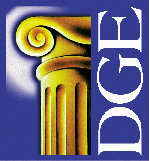CLAROS. Concordancia de Inscripciones griegas

The editors of the Diccionario Griego-Español (DGE) are pleased to announce the new release of CLAROS, the online concordance of Greek inscriptions, that can be accessed at <http://www.dge.filol.csic.es/claros/cnc/cnc.htm>.
CLAROS is a part of the DGE project. It is an electronic database containing the successive publications of epigraphical Greek texts re-edited during the last 125 years (and before). Users of CLAROS can consult the data relative to the edition of Greek inscriptions (name and date of publication, and the editor's name; but not the epigraphic text itself). More interestingly, users can retrieve the concordance BETWEEN inscriptions, that is, the different editions of the same inscription. In addition to the bibliographical reference to the main editions of an epigraphical text, CLAROS contains reference to numerous corpora of translations of the same Greek texts.
This new release of CLAROS contains more than 605,000 concordances between inscriptions published (in text or translation) in about 6,300 publications. This data was collected through the inspection of about 1000 epigraphical collections (including SEG and Bulletin Epigraphique). The main contribution of this upgrade, apart from 150.000 new concordances, is the introduction of almost 180.000 external links that connect the results of bibliographical searches with digital versions of publications. There are three kinds of links, each of them in a different color:
The red links connect with PDF papers in subscription platforms, which require some kind of payment for consulting complete papers, like JStor or Periodicals Archive Online.
The green links connect with hard copies (journals or books) in PDF or JPG format that may be consulted without restrictions in all kinds of platforms or repositories (École Française d'Athènes, Köln Universität, Gallica, Universitätsbibliothek Heidelberg, Persée, Revues.org, Internet Archive, etc.).
The blue links connect with digital editions of inscriptions, including both original editions (The Princeton Project on the Inscriptions of Anatolia in Searchable Greek Inscriptions, Inscriptions of Aphrodisias Project, Inscriptions of Israel / Palestine, etc.) and digital versions of corpora simultaneously or previously published (Inscriptiones Graecae, Monumenta Asiae Minoris Antiqua XI, Inscriptions of Roman Tripolitania, etc.).
The database can be consulted in Spanish, French and English at
<http://www.dge.filol.csic.es/claros/cnc/cnc.htm> Here you can learn more about the editions used, the criteria for the inclusion in the data base, and a full list of the bibliographical abbreviations. The editors of CLAROS would appreciate any suggestion for the improvement and enlargement of the data base. Please, send your letters to
juan.rodriguez@cchs.csic.es.
Quienes trabajan en epigrafía griega saben lo laborioso que resulta
a veces rastrear la bibliografía generada por una inscripción
o una serie concreta de inscripciones a lo largo de los años. El propósito
de la base de datos CLAROS es facilitar la tarea de localizar nuevas ediciones
de inscripciones griegas aparecidas a lo largo del último siglo. Está
pensada para servir de ayuda tanto a los especialistas en epigrafía griega
como a los historiadores, lingüistas y filólogos en general, menos
habituados que aquellos a desenvolverse en la jungla bibliográfica en
que se ha convertido esta disciplina.
El origen de esta base de datos se remonta al año 1990, cuando una
parte del equipo del DGE empezó a recoger en una versión previa
bajo entorno MSDOS este tipo de información con el fin de servir de ayuda
en la tarea de revisión del material epigráfico incluido en el
diccionario. Su filosofía es la misma que la de otras secciones de esta
página web: poner a disposición de los investigadores información
de uso interno del DGE que difícilmente vería la luz de
otro modo.
Esta Base de Datos en modo alguno pretende ser exhaustiva, ni aspira a recoger
todas las ediciones de cada inscripción citada. Es sencillamente una
suma de las concordancias que aparecen al final de numerosas colecciones epigráficas
publicadas en los últimos cien años, más o menos. A ello
se añade un cierto número de concordancias preparadas por los autores
del Supplementum Epigraphicum Graecum para volúmenes que carecían
de ella o la tenían incompleta y, por último,
un buen número de concordancias realizadas por nosotros directamente
para volúmenes que igualmente carecían de ella. Entre estos últimos pueden citarse por ejemplo colecciones como
GVI, ICr., Hell., IGR, INomima, ISE,
ISic.MG, RDGE, Schwyzer o Sokolowski...
 Presentación
Presentación
 Base de Datos
Base de Datos
 Colecciones
Colecciones
 Ayuda
Ayuda
Abreviaturas
 Lista
Lista
 Búsqueda
Búsqueda
Presentación
Base de Datos
Colecciones
Ayuda
Lista
Búsqueda

No comments:
Post a Comment